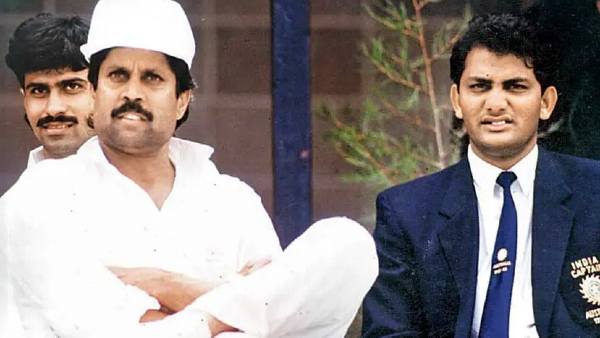
Caught Out review: Documentary on cricket match-fixing scandal merely skims the surface

Perhaps the most tragic outcome of the cricket match-fixing scandal that came to light in the late 1990s and early 2000s, as sports writer Sharda Ugra points out in the Netflix documentary Caught Out, was that it broke the hearts of thousands of fans, many of whom never watched another game of cricket again. Their faith in cricket and the cricketers had been completely eroded.
Supriya Sobti Gupta directs a Netflix documentary that provides a chronological account of the match-fixing scandal, leading up to the moment bookie M K Gupta reveals the identity of the man he claims he paid to fix matches: former Indian cricket captain Azharuddin. For documentaries like these to work when one has moved on from the subject of its work aeons ago, it should reveal something new or take it forward. Unfortunately, none of that happens in the documentary, and one wonders what was the reason for it to be featured now. Nevertheless, it raises important questions but never gets those addressed during the feature.

The calls of the bookies
Aniruddha Bahal, an investigative reporter for Outlook magazine, who, along with his colleague Krishna Prasad, exposed the scam, says in the documentary that he became a sports reporter by accident when his colleague covering sports fell ill, and he had to fill in. The documentary’s overarching theme is that the most significant revelations involving key cricketers happened by chance. For example, an anonymous caller to the Delhi Police claimed that specific individuals were threatening him and attempting to extort money from him. It prompted cops to monitor his phone calls, and during one of them, South African captain Hansie Cronje’s name was mentioned, and further investigation revealed that he was involved in the match-fixing scandal. After denying it earlier, Cronje confessed to his crimes but named a Delhi-based bookmaker, M K Gupta, the kingpin of the entire scam.
Also read: Rocket Boys Season 2 review: A montage of hope and courage, the personal and political
Bahal says in the documentary that while he knew a few sports journalists individually, he was always considered an outsider. “They never broke stories and never pointed fingers at the negative stuff. I felt they owed their audience much more,” says Bahal, indicating that, as journalists, their primary responsibility should have gone beyond mere reporting about matches. However, while at work, Bahal discovered that certain journalists reporting from the press box about a game had begun receiving anonymous calls about the outcome of a particular match, how the pitch would behave, and who would be dropped or retained in the team. He realised those were bookie calls and was outraged that the reporters were taking them even while reporting on the match.
The weak links
That’s when he began digging deeper and contacting bookies. He soon encountered someone who tipped him off, claiming that the former Indian cricketer Manoj Prabhakar might have some information about match-fixing. After several meetings, Prabhakar began sharing information about how matches are fixed and the bookies’ critical role. He even revealed that an Indian cricketer had offered him Rs 25 lakh to fix a game. Outlook went on to publish details of the scandal, but neither the Government nor the BCCI took it seriously. Instead, the cricket body denied match-fixing allegations and sued Prabhakar and the magazine for Rs 5 crore.

The Government intervened when the issue was raised in Parliament and ordered a CBI enquiry. It appointed Ravi Sawani, a joint director of the CBI, to lead the investigation. During the investigation, the bookie Gupta claimed that Indian cricket captain Mohammad Azharuddin was also involved, startling the cricketing world. As a result, the cricket board banned Azharuddin for life after the CBI claimed he confessed to his crime. Azharuddin later denied the allegations and successfully challenged the ban in court, which ruled in his favour. Another cricketer, Ajay Sharma, was also banned for life but was given a reprieve by the courts. However, Sawani maintains that Azharuddin was indeed involved in the scandal and that the court let him off on technical grounds.
The CBI, quite bizarrely, could not find any evidence against bookie M K Gupta and did not charge him, but those he had named, such as Azharuddin and Ajay Sharma, were found guilty. Prabhakar also named Kapil Dev, the cricketer who offered him Rs 25 lakh, but the CBI found no evidence to support his claim. However, the investigating agency claimed that a bookie named Prabhakar and the BCCI promptly barred him from playing cricket for five years. This reflects poorly on the CBI, as it found no evidence of wrongdoing in a person who had confessed to another CBI officer, Neeraj Kumar, that he was the root cause of all the problems confronting the cricketing world and shared evidence to back up his claim. This is where the documentary falls short, as Sawani is never asked these questions. It also does not mention Krishna Prasad’s contribution to the first expose.
Also read: Zwigato review: A tender, insightful portrait of the disenfranchised in shining India
An unprobed angle
While Bahal admits that Prabhakar was brave enough to reveal details about match-fixing and even faced a Rs 5 crore defamation case from the BCCI, the CBI ignores his contribution as a whistleblower but finds him guilty of being involved in the scandal after a bookie mentions his name. The documentary could have probed this angle further about the bookie’s claims, as he could have been planted to nail a whistleblower who left one of the sport’s richest bodies thoroughly shamed and embarrassed.
The makers of the documentary underplay the role of Prabhakar, who would have certainly considered the ramifications of his expose before accusing Kapil Dev of offering him a bribe to fix a match. The documentary, most of the time, skims the surface but gives enough time to paint Azharuddin as perhaps the biggest culprit in the scandal, even going to the extent of showing snatches of an interview by a lady who keeps asking him about his preference for international labels he wears and ending the conversation by saying that he hasn’t been entirely honest with his answers. It is never explained whether she has any evidence to support her claim. However, Neeraj Kumar’s statement that Gupta had “made enough money, and it was time for him to enjoy his earnings” shows that different yardsticks were used to measure him and Azharuddin while probing the allegations against them.
After watching the 77-minute documentary, one wonders whether the purpose behind it was quite different from what the makers would like us to believe.


